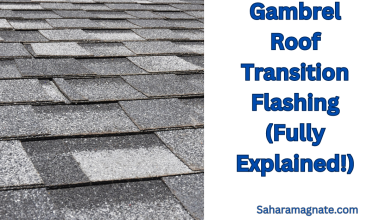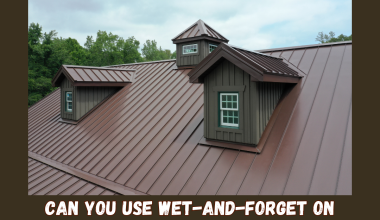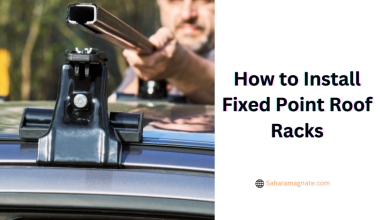If you want to add a patio roof to your existing house, you’ve come to the right place.
Whether you’re doing this as part of a home improvement project or just for fun, it’s an exciting DIY project that can significantly increase the value of your property.
Unfortunately, attaching a patio roof to an existing house is not as simple as it may sound.
From measuring and cutting lumber correctly to ensuring everything is properly sealed and secured, many vital steps must be taken when attaching a patio roof to an existing house.
Here, we will discuss how to attach a patio roof to an existing house so you know your new outdoor space is safe and secure.
Read on for more!
How To Attach a Patio Roof to An Existing House?
Attaching a patio roof to an existing house isn’t as difficult as it may seem. In fact, with the right materials and some careful measuring, you can complete this project in a matter of hours.
Here’s a brief overview of what you’ll need to do:
- Get suitable materials. You’ll need enough wood and other materials to construct the frame, shingles, or other materials for roofing. Make sure you also have nails, screws, and other fasteners capable of securely holding all the pieces together.
- Measure twice. Careful measuring is essential for ensuring that your patio roof is attached correctly and securely. Be sure to measure each connection point twice for accuracy before installing.
- Follow safety protocols. Before beginning work, ensure you know of any local safety protocols for working at heights on your home’s exterior. Additionally, consider wearing safety equipment such as eyewear, gloves, and a hard hat if appropriate.
- Install carefully. Starting with the frame and roofing material, take your time to install everything securely by following manufacturer instructions and using appropriate fasteners where needed.
Gathering the Supplies You Need
Before getting started, you must ensure you have all the supplies and materials you need for the job.
Here’s a comprehensive list of items you’ll need:
- Roofing nails
- Construction adhesive
- Caulk
- Hammer drill and bit
- Circular saw
- Jigsaw
- Measuring tape
- Framing square
- Sawhorses or plywood to lay on
Additionally, you’ll want to buy roofing material that matches your roof and building materials as much as possible.
This will help your patio roof blend in more seamlessly with your home. Determine the coverage area for your deck by measuring the space between the house and where your patio roof will end up.
Once you have these measurements, take them to a lumber yard or home improvement store and get the number of materials necessary for the job.
How to Construct the Roof Frame
If you’re ready to construct the roof frame, follow these steps.
Gather Materials
Before you get started, you’ll need the right materials, which can vary depending on the size and weight of your patio roof.
You’ll need supplies such as lumber and fasteners like nails and screws; be sure to double-check which ones are suitable for outdoor use.
You’ll also need brackets or rafters for attaching the patio roof to your house’s wall.
Calculate Weight
Once you’ve acquired the materials, you’ll need to figure out the frame’s weight to support it adequately.
This is especially important if you plan on constructing heavier wood or metal roofs. The weight your house can support depends on its construction type; a single-story home may not be able to bear more than two tons, while two stories require reinforced support to bear five tons.
Build the Roof Frame
This is where construction begins! Start by tracing lumber boards around the house’s walls to create a structure that matches its existing design.
For a pitched roof frame, use rafters attached perpendicularly across each other with nails and supports for bracing; for a flat roof frame, attach trusses similarly but with joists placed at 30-degree angles from one another into corner beams secured securely at each corner of your house’s walls with nails or screws.
Once your frame has been built, secure it against your house’s wall for extra stability and strength before adding other roof components, such as shingles or tiles.
Installing Trusses and Roofing Materials
Now it’s time to install the trusses and roofing materials. This is a crucial step — it ensures your patio roof is safely attached to your existing house.
First, you must ensure that the trusses are equal distances apart, with the same amount of pressure applied.
This will help ensure that your roof is even and takes the weight of whatever materials you choose.
Once you’ve installed the trusses, it’s time to add roofing material. You can choose from asphalt shingles, metal roofs, composite roofs, or a membrane roof like EPDM (ethylene propylene diene monomer).
Each type has its advantages, so research to find out which works best for your needs and budget.
As you install the roofing material, make sure to attach it securely using galvanized nails or screws that are corrosion-resistant — this will help ensure that your new patio roof will last for years to come!
Tips for Attaching the Roof to Existing Walls
If you are attaching a patio roof to an existing house, you must follow specific tips and tricks to ensure it is done correctly.
Here are some things to keep in mind:
Check the Wall Structure
Before attaching the roof, check the wall structure of your house to make sure it can support the weight of the roof. If not, you must strengthen it before proceeding with the installation.
Measure Twice, Cut Once
Accuracy is key when attaching a patio roof to an existing house; measuring twice and cutting once will help you get it right.
Ensure that all measurements are correct before drilling and cutting any material so that everything fits together perfectly.
Use Quality Supplies
Quality matters when installing a patio roof—always use high-quality materials such as galvanized steel or aluminum, and don’t skimp on fasteners.
Low-quality products aren’t worth risking your safety or the integrity of your patio roof!
Follow Safety Rules
When doing any construction work, safety should always come first. Be sure to follow all safety rules for working at heights and use proper protective gear, such as gloves and a hard hat, when necessary.
Never work alone—having an extra set of hands makes any project easier and safer!
Finishing Touches for the Roof
Once you’ve got the patio roof frame in place, it’s time to finish the job. That means choosing an appropriate roofing material and attaching it securely to your existing house.
Roofing Material
Many roofing materials are used for patios and houses, such as metal, asphalt shingles, rubber roofs, slate, tile, and more.
Depending on the style of your house and the look you’re going for, any of these can work—just make sure it’ll stand up to harsh weather conditions.
Attaching It Securely
Once you’ve picked out your roofing material, it’s time to attach it securely. Begin by nailing down felt paper on top of the rafters, then lay down the roofing material in strips over the felt paper.
Ensure that each strip is securely nailed down and that there are no gaps between them—this will ensure a watertight seal.
Finally, add a drip edge along the perimeter of your patio roof to help divert any water that may run off.
Follow these steps, and you’ll have a secure and sturdy patio roof that should last for many years!
Safety Considerations When Attaching a Patio Roof
When attaching a patio roof to an existing house, there are specific safety considerations that you should take into account.
After all, putting a structure up on the side of your home means considering the load it puts on the structure and how best to ensure it stays in place.
Here are some things to consider when attaching a patio roof to your existing house:
- Check local building codes and permitting requirements – Check with your local building department and find out what permits are necessary to add this type of structure to your home before starting the project.
- Inspect the existing structure – Make sure your existing house can support the additional weight of a patio roof by inspecting all areas where it will be attached for structural integrity. This includes checking for any water or rot damage and ensuring the wall is structurally sound.
- Choose the appropriate type of fasteners – Use heavy-duty fasteners like lag screws, bolts, and masonry anchors when attaching rafters or beams to your existing structure for maximum strength and stability.
- Use appropriate bracing – Bracing is essential when attaching anything heavy, like a patio roof, so it can withstand strong winds and other elements like rain, snow, and ice without shifting or coming loose from its mountings.
- Use waterproof sealants – Choose quality waterproof sealants around all joints where beams, rafters, and other components intersect so that water doesn’t seep in, which could cause rot or damage over time.
Conclusion
Building a patio roof is a big project, and ensuring everything is done correctly and safely is essential.
If you’re not confident in your skills or unsure how to attach a patio roof to your existing house, it’s best to call a professional.
They’ll be able to advise you on the best approach for your home, ensuring the job is done safely and successfully.
At the end of the day, attaching a patio roof to an existing house is a rewarding project. It can add value to your property and turn your outdoor space into an inviting and practical area.
With proper planning, preparation, and meticulous execution, you’ll be one step closer to enjoying your outdoor paradise.






